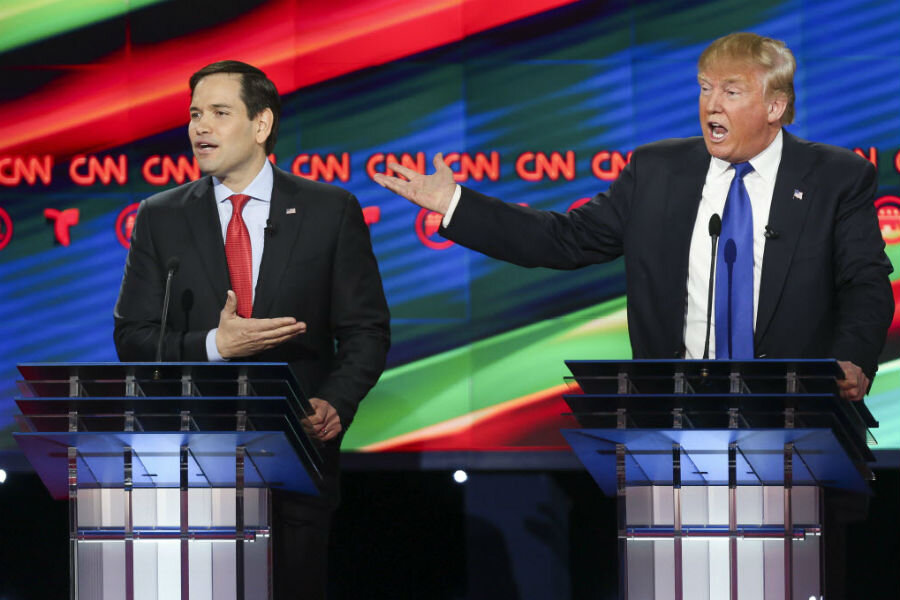Could the Trump-Clinton debate ratings reach Super Bowl levels?
Loading...
The first on-air showdown between presidential candidates Hillary Clinton and Donald Trump on Sept. 26 is predicted by experts to bring in as many as 100 million television viewers – reaching almost as many people as the Super Bowl.
It’s unusual for presidential debates to receive as much attention. But does more American interest in presidential debates signal increased political engagement – or does it reflect attraction to the spectacle of this year’s unusual elections?
According to The Hill, the 2012 presidential debates between President Obama and Mitt Romney averaged 66.4 million viewers across major broadcast and cable outlets. In contrast, the 2015 Super Bowl had 111.9 million viewers, which rose to 118.5 million during pop star Katy Perry’s performance at halftime.
This makes the debate an unexpected competitor for ad dollars with ESPN’s Monday Night Football. The Wall Street Journal reports that the football ratings are expected to drop 15 to 20 percent from last year’s average because of the debate.
“[Ratings will be up with] so many people still on the fence about who to vote for and the bitterness and nasty-fighting between the two,” Billie Gold, vice president and director of programming for the research arm at Dentsu Inc. told The Wall Street Journal, stating that the tension makes for great TV.
To be fair, the first presidential debate is crucial for the two candidates who are neck-to-neck in the latest polls. It will be the first time Trump is debating a Democratic candidate, and the theme on economics and security are especially relevant with Americans who are concerned about the recent attempted bombings in New York and New Jersey.
But on the other hand, many have pointed to Trump’s role in attracting larger audiences to the primary debates held over the past year.
CNN Money calls it the “Donald Trump ratings bump.” Trump has helped Fox News shatter its viewership records, especially when he clashed with Fox News anchor Megyn Kelly last August. That debate attracted 24 million viewers. Trump’s presence boosts viewership – the debate he refused to attend garnered 12.5 million viewers – while the other GOP debates with Trump present averaged between 14.5 million and 16.8 million viewers.
In the lead up to the primaries, the audience for Republican debates surpassed those watching the Democratic debates. According to data from television analytics firm Nielsen as reported by The Wall Street Journal, the eight Republican debates drew an average of 16.2 million viewers per forum compared to 9.2 million viewers for the Democratic debates which tended to be less contentious.
The Christian Science Monitor's Peter Grier says Trump's communication style, perhaps honed as the star of "The Apprentice," is particularly effective in this age.
Donald Trump’s extraordinary victory in the Republican presidential primaries was due in part to the way he communicates. His words, his gestures, his expressions, his emphasis – all are uniquely suited to the pace and attention span of our social-media saturated age.
He’s brief. He’s punchy. He’s repetitive, repetitive, repetitive. Sentences aren’t completed or take exits toward unexpected destinations. Multi-syllable words are kept to a minimum. Effective!
This all occurs as viewership for presidential debates have fallen over the years, according to a study by the Annenberg Public Policy Center of the University of Pennsylvania. Debates, especially the first presidential debate, according to some political scientists, are still useful in helping voters learn more about candidates.
But entertainment value or not, this year’s debates appear to have played a significant role in fueling public interest in politics. According to a Pew Research poll in December 2015, up to 69 percent of the surveyed said they watched at least some debates between the candidates, compared to just 43 percent who did so in 2007. Nearly two thirds say it has been helpful for them to learn about the candidates.






